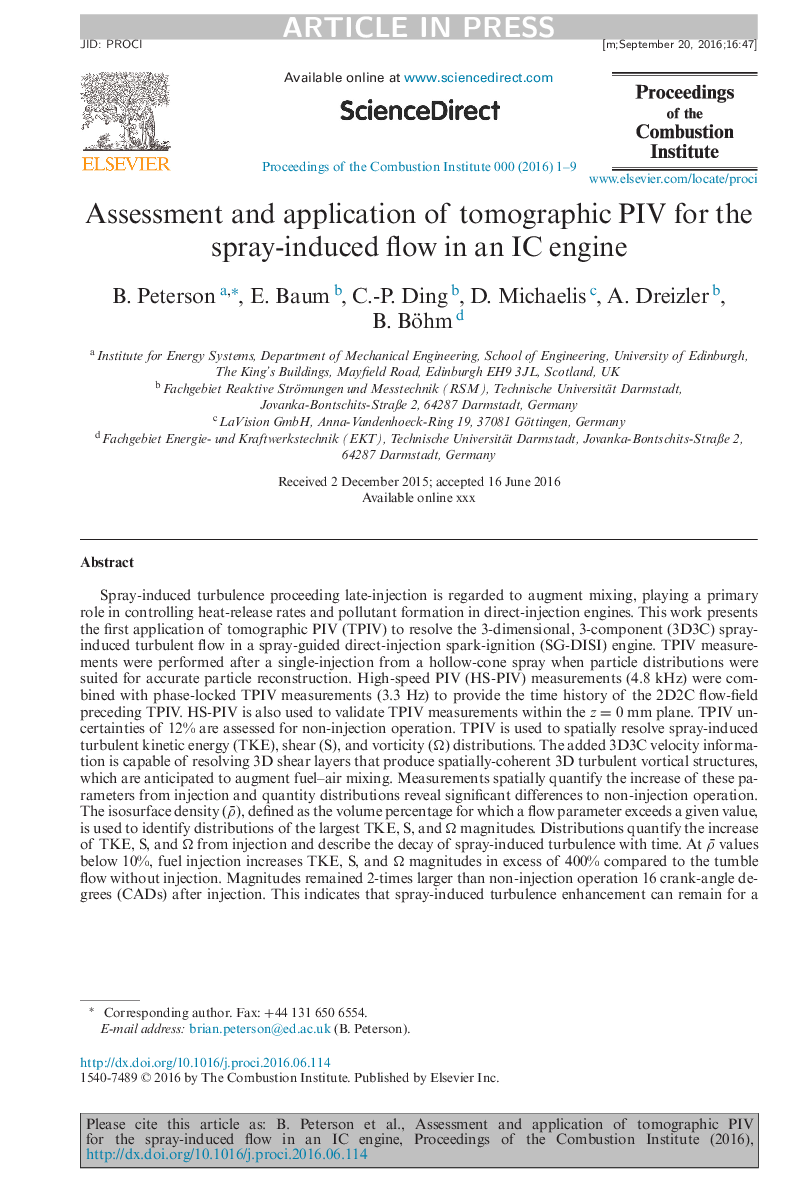| کد مقاله | کد نشریه | سال انتشار | مقاله انگلیسی | نسخه تمام متن |
|---|---|---|---|---|
| 4915400 | 1427915 | 2017 | 9 صفحه PDF | دانلود رایگان |
عنوان انگلیسی مقاله ISI
Assessment and application of tomographic PIV for the spray-induced flow in an IC engine
دانلود مقاله + سفارش ترجمه
دانلود مقاله ISI انگلیسی
رایگان برای ایرانیان
کلمات کلیدی
موضوعات مرتبط
مهندسی و علوم پایه
مهندسی شیمی
مهندسی شیمی (عمومی)
پیش نمایش صفحه اول مقاله

چکیده انگلیسی
Spray-induced turbulence proceeding late-injection is regarded to augment mixing, playing a primary role in controlling heat-release rates and pollutant formation in direct-injection engines. This work presents the first application of tomographic PIV (TPIV) to resolve the 3-dimensional, 3-component (3D3C) spray-induced turbulent flow in a spray-guided direct-injection spark-ignition (SG-DISI) engine. TPIV measurements were performed after a single-injection from a hollow-cone spray when particle distributions were suited for accurate particle reconstruction. High-speed PIV (HS-PIV) measurements (4.8 kHz) were combined with phase-locked TPIV measurements (3.3 Hz) to provide the time history of the 2D2C flow-field preceding TPIV. HS-PIV is also used to validate TPIV measurements within the z = 0 mm plane. TPIV uncertainties of 12% are assessed for non-injection operation. TPIV is used to spatially resolve spray-induced turbulent kinetic energy (TKE), shear (S), and vorticity (Ω) distributions. The added 3D3C velocity information is capable of resolving 3D shear layers that produce spatially-coherent 3D turbulent vortical structures, which are anticipated to augment fuel-air mixing. Measurements spatially quantify the increase of these parameters from injection and quantity distributions reveal significant differences to non-injection operation. The isosurface density (ϯ), defined as the volume percentage for which a flow parameter exceeds a given value, is used to identify distributions of the largest TKE, S, and Ω magnitudes. Distributions quantify the increase of TKE, S, and Ω from injection and describe the decay of spray-induced turbulence with time. At ϯ values below 10%, fuel injection increases TKE, S, and Ω magnitudes in excess of 400% compared to the tumble flow without injection. Magnitudes remained 2-times larger than non-injection operation 16 crank-angle degrees (CADs) after injection. This indicates that spray-induced turbulence enhancement can remain for a significant time after injection. Measurements and analyses provide insight into spray-induced turbulence phenomena and are anticipated to support predictive model development for engine sprays.
ناشر
Database: Elsevier - ScienceDirect (ساینس دایرکت)
Journal: Proceedings of the Combustion Institute - Volume 36, Issue 3, 2017, Pages 3467-3475
Journal: Proceedings of the Combustion Institute - Volume 36, Issue 3, 2017, Pages 3467-3475
نویسندگان
B. Peterson, E. Baum, Ding C.-P., D. Michaelis, A. Dreizler, B. Böhm,